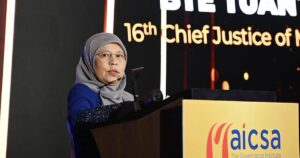
From William Dennis
I refer to the story “KLIA’s fatal flaw: An international hub without transfers” in Free Malaysia Today on Sept 8.
As one who has worked closely with the civil aviation industry in the Asia-Pacific and Europe for 32 years, I would like to say that the facility’s shortcomings are more just the lack of transfers between terminals.
It is more than 27 years since the airport opened for operations on June 28, 1998 but the inconvenience of the frequent breakdown of the aerotrain service at Terminal 1 since it was relaunched on July 1, 2025 has rubbed salt into the wound.
The day after it came back online, there was interruption to the service.
Then on July 4 it was halted again due to water seepage in the tunnel.
On Aug 4 a technical issue, as claimed by Malaysia Airports Holdings Bhd (MAHB), saw the service interrupted again.
On Sept 3, a power trip resulted in one of the trains stopping for a short while.
It is difficult to fathom that despite a whopping RM456 million invested in the new trains, there already are frequent disruptions within two months.
The traffic congestion on Levels 3 and 5 is a test of one’s patience.
You do not see this at any other airport in the region.
The long wait for your luggage is another problem yet to be resolved.
With MAHB having plans to integrate Terminals 1 and 2, it looks like a heinous task for the airport operator as the two terminals are not physically linked.
Terminal 1 is a facility for full-service airlines while Terminal 2 is a low-cost airlines terminal (LCCT).
Integrating one with the other can lead to increased passenger volume, so expect potential service disruptions like long queues and delays resulting in frustration due to diverse service expectations and operational complexities for airlines and staff.
Complex operational challenges due to differing service models cannot be avoided.
Full-service airlines could also face challenges in maintaining brand image when they are grouped with low-cost carriers (LCCs) that offer a different service model.
These issues are likely to strain airport resources, such as security and airport check-in counters.
I am not wrong to say it will have a negative impact on customer experience, which is likely to cause confusion and missed connections if the integration is poorly managed.
A major disadvantage of the lack of a link between the terminal for full-service airlines and an LCCT is the disruption to connectivity which hinders an airport’s ability to serve as an efficient aviation hub.
The distance between Terminal 1 (for full-service airlines) and Terminal 2 (LCCT) creates significant obstacles for passengers and airlines, leading to longer minimum connecting times.
Passengers who need to transfer between a full-service carrier and an LCCT must exit at the airside area, reclaim their luggage, and travel between terminals on the ground before checking in and going through security again.
This is unfeasible.
Effective integration requires significant coordination between airlines and airport authorities to ensure a smooth flow of passengers and trouble-free service.
As for operational complexity, managing two distinct service models in one terminal can be very challenging, particularly in staffing and resource allocation.
Terminal 1 was built for a passenger handling capacity of 25 million but is operating over design capacity, while Terminal 2, with a capacity of 45 million, is under capacity.
There has been no physical expansion of Terminal 1 since KLIA opened for operations to accommodate increased passenger capacity.
One way of easing congestion at Terminal 1 is to move Firefly and Batik Air operations, both budget carriers, to Terminal 2.
In my view, Terminal 2 should continue to operate as a dedicated LCCT and Terminal 1 for the full-service airlines.
Changi Airport’s Terminal 4 is an LCCT while Don Mueang International Airport is dedicated to low-cost airlines operations.
MAHB should seriously consider building a third terminal to link to Terminal 1 if it hopes to rival Changi Airport and Bangkok’s Suvarnabhumi Airport.
Changi Airport has started construction of Terminal 5 while Suvarnabhumi Airport is currently building its new South Terminal.
On another note, it is often that the landing announcement at KLIA by the cabin crew of most airlines say KL International Airport, not Kuala Lumpur International Airport.
It must be noted that KL is an acronym, not a name.
William Dennis is a veteran in the aviation industry and an FMT reader.
The views expressed are those of the writer and do not necessarily reflect those of FMT.






